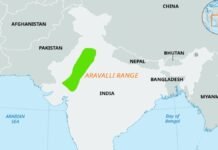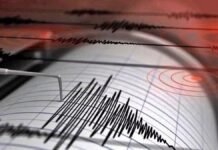
New Delhi: A powerful earthquake struck Japan and Taiwan early Wednesday morning, resulting in the tragic loss of four lives, significant structural damage, and the triggering of a tsunami. The quake, which was felt strongly in the southeastern city of Hualien, caused extensive damage to a five-story building, with its first floor collapsing and the remaining structure left dangerously tilted. In Taipei, the tremors dislodged tiles from older buildings and disrupted operations in modern office complexes.
In a swift response to the crisis, students were evacuated from schools and provided with helmets for protection, while some resorted to using books as shields against falling debris. The National Fire Agency confirmed the death toll in Hualien county and reported that the tsunami threat had subsided two hours post-quake. The seismic event led to a temporary halt of train and subway services across the island, which is home to a population of 23 million.
The earthquake also inflicted damage on the National Parliament building, a historic structure housing a pre-World War II school. The natural disaster caused landslides and debris falls, leading to severe traffic disruptions, particularly in mountainous regions. Despite the magnitude of the quake, the populace remained relatively calm, a testament to the country’s frequent earthquake occurrences and the regular emergency drills conducted in schools. Authorities disseminated safety advisories through media and mobile alerts.
Japan’s Meteorological Agency observed a tsunami wave measuring 30 centimeters on Yonaguni Island shortly after the quake, with smaller waves detected on Ishigaki and Miyako islands. Initial warnings of waves reaching up to three meters were later downgraded. Japan deployed military aircraft to assess the tsunami’s impact around Okinawa. Taiwan’s earthquake monitoring agency recorded the quake’s magnitude at 7.2, while the US Geological Survey reported a slightly higher magnitude of 7.4.
The quake struck at 7:58 am local time, with its epicenter located approximately 35 kilometers underground, south-southwest of Hualien. An aftershock, registering a magnitude of 6.5, followed by its epicenter at a depth of 11.8 kilometers. The tremors were felt as far away as Shanghai and along China’s southeastern coast, though no tsunami warnings were issued for the mainland. Japan reported no casualties or property damage.

The Pacific Tsunami Warning Center confirmed that there was no tsunami threat to Hawaii or Guam. Three hours after the main tremor, the tsunami threat was deemed to have passed in all regions, with only Taiwan and southern Japan reporting waves. Residents along the northern coast of the Philippines were advised to seek higher ground, but no significant tsunami waves were reported. This event recalls the memory of Taiwan’s most devastating earthquake in recent history, which occurred on September 21, 1999, with a magnitude of 7.7, claiming 2,400 lives, injuring approximately 100,000, and causing widespread destruction.


















































